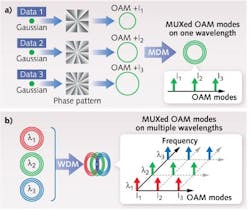OPTICAL COMMUNICATIONS: OAM multiplexing plus WDM reaches 100 Tbit/s
Combining two different orthogonal multiplexing techniques can dramatically increase communications capacity. Researchers at the University of Southern California (USC; Los Angeles, CA), Tel Aviv University (Tel Aviv, Israel), the Jet Propulsion Laboratory (JPL; Pasadena, CA), and the University of Glasgow (Glasgow, Scotland) have done precisely that: they have combined mode-division multiplexing using orbital angular momentum (OAM) with wavelength-division multiplexing (WDM) to achieve a communications capacity of just above 100 terabits per second (Tbit/s).1
OAM mode-division multiplexing
Laser beams that have a spiral phase term in their wavefront that depends on azimuthal angle and have a “donut-like” ring-shaped intensity profile are called OAM modes. Numerous spatially colocated OAM modes with different OAM values, both positive and negative (clockwise and counterclockwise phase rotations, respectively) and even with different polarization states, can be multiplexed together via modedivision multiplexing to transmit multiple independent data channels on the same wavelength (see figure).
In this high-capacity communications demonstration, the researchers use a spatial light modulator (SLM) with a specially designed spiral phase pattern to generate a superposition of three beams from a Gaussian input: OAM+4, OAM+10, and OAM+16. A second SLM generates superposed OAM+7, OAM+13, and OAM+19 beams. These six OAM beams are then split into two identical copies; one that is reflected by a certain timeframe using mirrors and delayed from the first copy, creating another six OAM beams with opposite OAM values. Finally, 12 OAM beams from the second step are split again into two copies, one of which is delayed and polarization-adjusted to be orthogonal to the other copy. These two copies are combined using a polarization beamsplitter and the resulting 24 OAM beams (OAM±4, ±7, ±10, ±13, ±16, ±19 on x- and y-polarization states, respectively) are obtained.
Now add WDM
The WDM transmitter has 42 lasers with 100 GHz spacing from 1536.34 to 1568.50 nm multiplexed together with an array-waveguide grating. The channels are modulated to achieve 100 Gbit/s quadrature phase-shift keying (QPSK) data on each WDM channel.
Each of the 24 OAM modes is multiplexed with the 42 lasers (each at 100 Gbit/s) for an aggregate (24 × 42 × 100) communications capacity of 100.8 Tbit/s. Measured data for the demultiplexed channels yields an optical signal-to-noise ratio penalty for wavelength crosstalk of approximately 0.4 dB; OAM crosstalk is approximately 1.8 dB at a respectable bit-error rate of 3.8 × 10-3.
“The results indicate that OAM multiplexing is compatible with WDM,” says USC professor Alan Willner. “They can be combined together to potentially improve the capacity of an optical data link, especially for situations that require high capacity or high spectral efficiency over relatively short distances. Using OAM for optical communication is still a young field; although many challenges remain, the prospects are indeed exciting.”
REFERENCE
1. Hao Huang et al., “100 Tbit/s Free-Space Data Link using Orbital Angular Momentum Mode Division Multiplexing Combined with Wavelength Division Multiplexing,” 2013 OFC/NFOEC conference paper OTh4G.5 (March 21, 2013).
About the Author

Gail Overton
Senior Editor (2004-2020)
Gail has more than 30 years of engineering, marketing, product management, and editorial experience in the photonics and optical communications industry. Before joining the staff at Laser Focus World in 2004, she held many product management and product marketing roles in the fiber-optics industry, most notably at Hughes (El Segundo, CA), GTE Labs (Waltham, MA), Corning (Corning, NY), Photon Kinetics (Beaverton, OR), and Newport Corporation (Irvine, CA). During her marketing career, Gail published articles in WDM Solutions and Sensors magazine and traveled internationally to conduct product and sales training. Gail received her BS degree in physics, with an emphasis in optics, from San Diego State University in San Diego, CA in May 1986.
